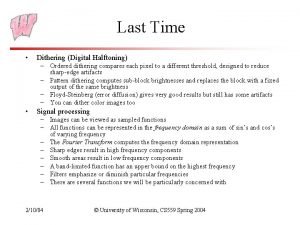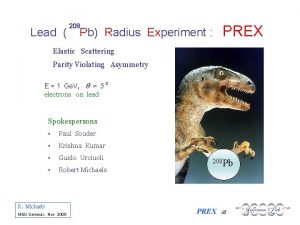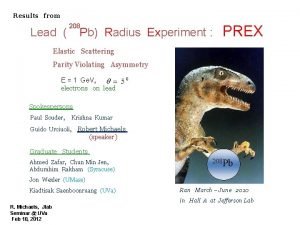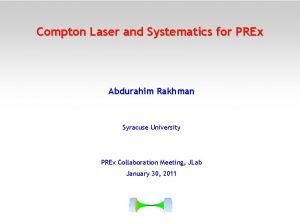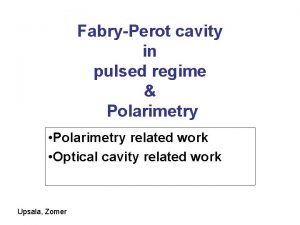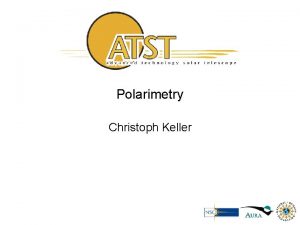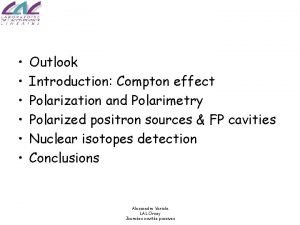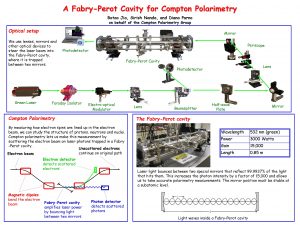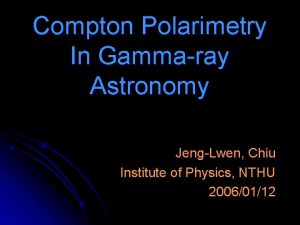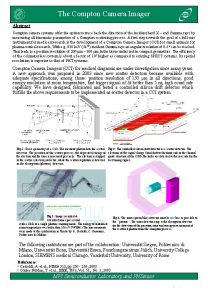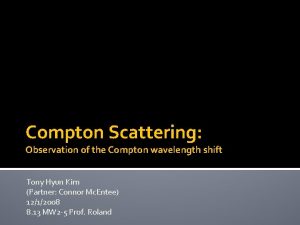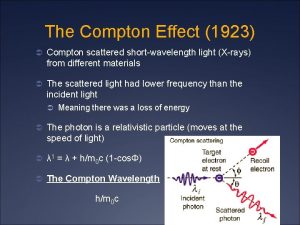2010 PREx Run Dithering Compton Polarimetry ChunMin Jen




















- Slides: 20

2010 PREx Run – Dithering & Compton Polarimetry Chun-Min Jen on behalf of the Hall-A collaboration @ JLab. Institution: Syracuse University, NY, 13244, USA E-mail: cjen@physics. syr. edu supervised by P. A. Souder, R. S. Holmes

Dithering for high-current (70 u. A) runs where are we?

What’s New in PREx beam modulation system? OFF_STATE start a super-cycle FFB (Fast Feed-Back) was paused start looping over the coil sequence allow beam modulation to be controlled? ON CONFIG_STATE driving a sine wave with a specific set of frequency (10 - 250 Hz) and amplitude (0 - 300 m. Amps) loading to VMI 4145 function generator, enter the number of periods (1 - 511) connected to the trim card relay is open function generator to configure set relay is closed trigger requested set function generator to trigger TRIGGER_STATE a sine wave was triggered

What do we Learn from PREx Dithering? • We make use of FFT (fast Fourier Transformation) to see the frequency spectrum in PREx dithering data as well as MC, which is generated with signals plus random noises. The random noise's frequency spectrum is rather flat (red graph), and it suggests us the probability of finding all of the possible noise's frequencies, except for the signal's, be "equal. " In contrast, PREx dithering data are composed of not only the driving frequency but lowfrequency noises which are resulted from "slow drift". MC obviously, flat at lower frequency run 4755, cycle 61 curvature at lower frequency run 4755, cycle 61

Monitor against Coil Dithering Slope • Here, we showed you monitor against coil dithering slope history plot. According to this, the dithering slope is very stable with time, and there exists very tiny fluctuations which are negligible. • Certainly, we applied a list of standard cuts to our dithering data. •

Detector against Coil Dithering Slope • Here, we looked at detector (normalized to beam current) against coil dithering slope history plot.

Sinusoidal Fit

Sinusoidal Fit – Phase Shift Understanding

Rich’s work Some dithering outliers are found to be associated with apparent problems with dithering. In each dither cycle a large BPM transient marks the restoration of feedback, which is turned off before the cycle begins. In a few cycles the feedback restoration occurs too early, before dithering is over. This early restoration results in energy vernier dithering slopes close to zero and large phase differences in the position BPMs with respect to the coils. A cut on small energy slope eliminates these bad cycles.

regress-corrected (black-line) v. s. dither-corrected (red-line) UMass regression SU dithering

Compton Polarimetry where are we?

Compton Polarimeter for PREx – convention dictionary • T : sum. ON, where ON means “laser-on” • S (or called sig in plots) : T – B, where B is either Bkg 1 (background type 1) or Bkg 2 (background type 2) • diff : diff. ON, where ON means “laser-on” • Araw : raw asymmetry is defined as • Acor (from data points) : corrected asymmetry is defined as • 1 st-kind Acor (based on the raw asymmetry) : defined as • 2 nd-kind Acor (based on the raw asymmetry) : defined as • • Δdiff : RMS of diff distribution Δ(T-B) : RMS of (S = T – B) distribution • dilution factor f is defined as weighted average

Compton Polarimeter for PREx – background level study in each laser cycle (1) accumulator type laser off after in each laser cycle, there are each laser cycle a bunch of MPS pulsars. laser on right laser on left laser on right for each pair of MPS pulsars with the opposite sign of helicity state (+/-), the “corrected” asymmetry can be obtained based on the following formula: laser off before take the mean of the sum of both of the histograms

Compton Polarimeter for PREx – Raw/Corrected Asymmetry / background level study in each laser cycle (2) systematic error from the beam condition and the accelerator ? ? ? how to estimate ? ? ? go to the next slide… the statistical weighted average

Compton Polarimeter for PREx – background level study in each laser cycle (3) 0 v Since we cannot measure Btrue, the way that we can estimate how large ΔB is can be based on the fluctuation of T-Bmeas. distribution. v Furthermore, we found In other words,



before 2010 Fall ü done_ investigate the discrepancy in “everything” between two adjacent laser states, i. e. laser-left and laser-right state. ü done_ investigate the error’s error (or called more accurately, residual) in σB 1, σB 2, σT and σ(T-B), while applying the linear fitting to the B 1, B 2, T and (T-B) functions. ü done_ done investigate the discrepancy between pair-wise asymmetry as well as laser (-cycle) wise asymmetry ü done_ done study the selection criteria further ü done_ done give the average of laser cycle wise asymmetry measurement in accumulator 0 for PREx ü done_ done yield the best fit c 2 value ü done_“suppress” the statistic error (background done suppression) in the average of beam polarization measurement ü done_yield the average of beam polarization measurement done in accumulator 0 for PREx

Compton Analyzing Power • without adding PMT non-linearity. • without adding smearing of resolution • adding pile-up and pile -down events • there’s no obvious difference between with and without pile-down effect

Future Plan – where we are going to be • Dithering – – asked to finish low-current slugs; keep looking at the stability of dithering data quality • Compton – – need to complete the estimation of systematic uncertainties
 Ordered dithering
Ordered dithering Polarimetry definition in chemistry
Polarimetry definition in chemistry Biots law polarimetry
Biots law polarimetry Polarimetry organic chemistry
Polarimetry organic chemistry Prex cold laser
Prex cold laser Hebeler
Hebeler Prex cold laser
Prex cold laser Prex cold laser
Prex cold laser Prex cold laser
Prex cold laser Brigitta olsen
Brigitta olsen Short run and long run equilibrium in perfect competition
Short run and long run equilibrium in perfect competition Run lola run editing techniques
Run lola run editing techniques Brigitta manthey
Brigitta manthey Short run vs long run economics
Short run vs long run economics Long run supply curve
Long run supply curve Multirule plus
Multirule plus Run lola run themes
Run lola run themes Jen southern
Jen southern Jen andre
Jen andre Fu jen university foundation
Fu jen university foundation Jean val jen
Jean val jen
